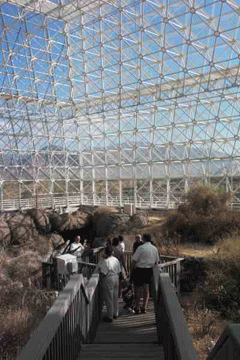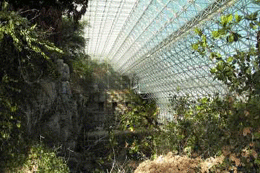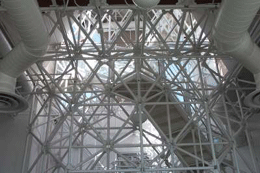Biosphere 2 PLUS 15
Air Date: Week of March 17, 2006

Public tours inside the biosphere. (Photo: Rene Gutel)
A look back at the people who locked themselves inside a giant terrarium in Oracle, Arizona 15 years ago as part of an experiment in environmental science. Rene Gutel of member station KJZZ has an audio collage of the history, ecology and human frailty that was Biosphere Two.
Transcript
CURWOOD: It’s Living on Earth. I’m Steve Curwood. Fifteen years ago, four men and four women walked inside a huge glass and steel terrarium in Oracle, Arizona, and locked themselves in for the next two years. The project and the structure were called Biosphere 2, and “the Biospherians,” as they called themselves, lived in the closed, supposedly self-sufficient environment, with an eye towards the future colonization of space. It was not easy. They struggled to maintain healthy oxygen levels, and struggled among themselves. From member station KJZZ in Phoenix, Renee Gutel has this look back at Biosphere 2, the people who were part of it, and some of the lessons they learned.
POYNTER: My name is Jane Poynter, and I’m one of eight people that lived inside Biosphere 2 for two years and 20 minutes. Before we went into Biosphere 2 the project was the poster child, if you will, for space exploration, for environmental and ecological research. It really did talk about hope for humanity and vision for the future. But I think it was overhyped.
[MUSIC]
PETER JENNINGS: Tonight we put a fascinating look into our future on the American agenda. A look into the future through the eyes and thoughts of eight men and women who are about to enter a tiny, manmade world in the middle of the Arizona desert.
LOCAL NEWSCASTER: Well, today we’re another step closer to creating the space station of the future.

A view of the rainforest and ocean biome from within the biosphere. (Photo: Rene Gutel)
POYNTER: You have to remember that when we started this project in the mid-80s, almost everyone was saying, you know, is this possible? The whole thing’s going to turn into green slime! You’re all going to get some terrible lung infection and die! People really did have some serious questions about whether sealing people up inside an enclosed environment with all these plants and animals was suicide.
[MUSIC]
LEIGH: I’m Linda Leigh. I’m a systems ecologist, and for eight years I was involved in the Biosphere 2 project. From 1991 through 1993 I was a Biospherian, and I lived inside with seven other people without coming out for two years.
POYNTER: We went into the facility on September the 26th, 1991.

Inside the biosphere. (Photo: Rene Gutel)
GOVERNMENT SPOKESMAN: Office of the Governor Proclamation, Arizona Biosphere 2 closure celebration date.
[APPLAUSE]
LEIGH: We walked in, the door closed, and finally, when we walked up into our living quarters, we weren’t being filmed anymore and we all just gave a big sigh of relief that we made it. It’s kind of like, finally!
[MUSIC]
LEIGH: When we closed the door in the Biosphere the oxygen level was a little bit lower than the ambient – and the ambient being what we breathe right here outside – and the carbon dioxide was a little bit higher than the ambient. And after a period of months the carbon dioxide kept increasing inside and the oxygen was decreasing. So we not only had an atmosphere that was not very healthy for humans, because of the low oxygen and high CO2, but we had a puzzle. We had a mystery.
POYNTER: At the time, everyone cringed and went, “Oh my goodness! You know, everybody’s going to think, you know, we’re complete frauds now because we’ve got this oxygen problem!”
LEIGH: And we said, “well, we can either all go out and take the vertebrate animals with us, or we can stay in and write it down and die, or we can add oxygen from the outside and see what we can do to try to lower the CO2. “
POYNTER: You feel incredibly lethargic. It gives you mood swings, it can cause depression, it’s difficult to do anything. You couldn’t complete a sentence without taking a breath. It was really quite dreadful.
[MUSIC]
LEIGH: What it felt like was eight crabby people trying to live together and work really hard together. And when the oxygen was added, I’ve got to say, a big weight seemed to be lifted.
POYNTER: We ended up having to add oxygen because it was a medical issue. I mean, you just can’t survive on the amount that was in the atmosphere when we pumped it in. It was at 14.2 percent when we pumped in oxygen. And yeah, we let it go down as far as we could.
[MUSIC]
POYNTER: The crew of eight people divided into two factions of four around the sixth month mark.
LEIGH: The split was contentious. When I look back at my behavior during that time I feel pretty shocked. It was really awful. Where I would be so cold to the people in the other group, walking by them and not even looking at them. And, you know, you’re in a close system – there’re only eight people – that’s pretty awful.
LEIGH (ARCHIVAL AUDIO): I mostly miss my friends on the outside in Biosphere 1. The most important message that I personally have is the message of being able to communicate. And certainly inside of Biosphere 2, in order to make the entire system work, we need to be able to talk to each other and to discuss with each other what’s happening.
[MUSIC]
LEIGH: You know, a lot of what that was about was resources. We didn’t have enough food, we didn’t have enough water, we didn’t have enough time.

Underground in the biosphere. (Photo: Rene Gutel)
[MUSIC]
NEWSCASTER: Biosphere. Some charge it could bring an early end to the scientific project. The Tucson TV report reveals scientists learned the plants alone could not remove enough carbon dioxide from the indoor atmosphere.
PETER JENNINGS: When it opened it was touted as a prototype for human colonies in space. It’s going to be very difficult if they have the kind of trouble in space that they’re having near Tucson.
[MUSIC]
LEIGH: Unfortunately, we set ourselves up for failure by saying at the outset that we were not going to add anything for a hundred years.
POYNTER: I think a lot of people felt betrayed, to some degree, because, you know, we had said we’re not going to take anything in! It’s going to be materially closed. Well, of course, I mean that’s really a rather ridiculous statement.
LEIGH: There is our core group of people, the Biospherians and a few of the other people involved in the idea of the Biosphere, who are like a little army of people who were convinced that it was going to be absolutely perfect when we closed the door. It’s silly in retrospect, but maybe we had to think that way in order to get it done.
[MUSIC]
CURWOOD: Our look back at Biosphere 2 was produced by Renee Gutel. By the way, if you’re looking for some prime Arizona real-estate, Biosphere 2 is up for sale. One developer is already eyeing the site for luxury homes. But BYOO – bring your own oxygen. To see photos of Biosphere 2 see our website, Living on Earth dot org.
Living on Earth wants to hear from you!
Living on Earth
62 Calef Highway, Suite 212
Lee, NH 03861
Telephone: 617-287-4121
E-mail: comments@loe.org
Newsletter [Click here]
Donate to Living on Earth!
Living on Earth is an independent media program and relies entirely on contributions from listeners and institutions supporting public service. Please donate now to preserve an independent environmental voice.
NewsletterLiving on Earth offers a weekly delivery of the show's rundown to your mailbox. Sign up for our newsletter today!
 Sailors For The Sea: Be the change you want to sea.
Sailors For The Sea: Be the change you want to sea.
 The Grantham Foundation for the Protection of the Environment: Committed to protecting and improving the health of the global environment.
The Grantham Foundation for the Protection of the Environment: Committed to protecting and improving the health of the global environment.
 Contribute to Living on Earth and receive, as our gift to you, an archival print of one of Mark Seth Lender's extraordinary wildlife photographs. Follow the link to see Mark's current collection of photographs.
Contribute to Living on Earth and receive, as our gift to you, an archival print of one of Mark Seth Lender's extraordinary wildlife photographs. Follow the link to see Mark's current collection of photographs.
 Buy a signed copy of Mark Seth Lender's book Smeagull the Seagull & support Living on Earth
Buy a signed copy of Mark Seth Lender's book Smeagull the Seagull & support Living on Earth

